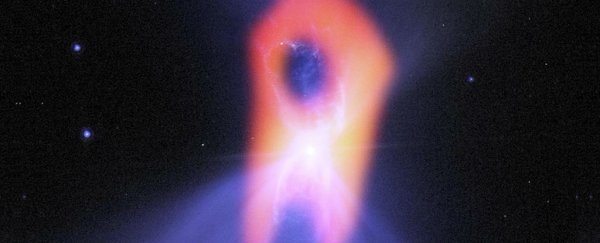Some 5,000 light-years from Earth, there's a bizarre and mysterious nebula that clocks an average temperature of just 1 Kelvin (−272.15 °C or −457.87 °F), making it the coldest natural object in the known Universe.
For decades, scientists have struggled to explain how this otherwise unremarkable cloud of gas maintains temperatures colder than empty space itself, but now they finally have an answer - another star took a death plunge into this dying star's heart.
The Boomerang nebula is thought to be a protoplanetary nebula, which is a transitional phase in a dying star's life that sits between the bulging red giant stage and the final planetary nebula - a glowing shell of ionised gas ejected from the collapsing red giant.
Our own Sun is predicted to follow this process in the next few billion years as it runs out of hydrogen fuel - it will swell up into a red giant, endure the intermediary protoplanetary phase for no more than 10,000 years, and then start to shed the outer layers that will form a planetary nebula.
The newly exposed core of our Sun will continue to cool and shrink and become a white dwarf - a stable star with no nuclear fuel. After billions of years, the white dwarf will lose all of its remaining heat and become a cold, black dead star.
But what if our Solar System had not one, but two Suns?
Based on new information from the Atacama Large Millimeter/submillimeter Array (ALMA), a series of radio telescopes in the Atacama desert of northern Chile, researchers think that the Boomerang nebula is so cold because a smaller companion star threw itself into the heart of a larger red giant, causing most of the red giant's matter to be ejected as an ultra-cold outflow of gas and dust.
This is the first time that scientists have been able to achieve precise calculations of the nebula's age, mass, and kinetic energy.
"These new data show us that most of the stellar envelope from the massive red giant star has been blasted out into space at speeds far beyond the capabilities of a single, red giant star," says lead researcher, Raghvendra Sahai, an astronomer at NASA's Jet Propulsion Laboratory.
"The only way to eject so much mass and at such extreme speeds is from the gravitational energy of two interacting stars, which would explain the puzzling properties of the ultra-cold outflow."
This outflow is expanding 10 times faster than it would in a single star, traveling more than 150 kilometres per second (93 mps), and plunging the protoplanetary nebula into temperatures of just 1 degree Kelvin.
To put that into perspective, zero degrees Kelvin is known as absolute zero - a potentially impossible point at which all thermodynamic motion stops.
It's also colder than the cosmic microwave background - the 'afterglow' of the Big Bang, and the natural background temperature of empty space, which has an average temperature of 2.725 Kelvin (–270.4 °C or -454.7 °F).
"The extreme properties of the Boomerang challenge the conventional ideas about such interactions, and provide us with one of the best opportunities to test the physics of binary systems that contain a giant star," says one of the researchers, astronomer Wouter Vlemmings from the Chalmers University of Technology in Sweden.
Of course, while all of this fits the evidence we have on the Boomerang Nebula, and very easily explains its ultra-cold temperatures, it will be up to scientists to find more evidence of this smaller companion star before we can know for sure.
Something we do know is that the coldest object in the Universe won't hold that distinction forever - the team found that the protoplanetary nebula is now starting to warm - and they think we could find other objects just like it, elsewhere in the Universe.
"We see this remarkable object at a very special, very short-lived period of its life," says one of the team, Lars-Åke Nyman, from the Joint ALMA Observatory in Chile.
"It's possible these super cosmic freezers are quite common in the Universe, but they can only maintain such extreme temperatures for a relatively short time."
The research has been published in The Astrophysical Journal.
